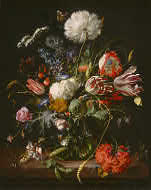
|
Jan Davidsz de Heem (artist) Dutch, 1606 - 1683/1684 Vase of Flowers, c. 1660 oil on canvas Overall: 69.6 x 56.5 cm (27 3/8 x 22 1/4 in.) framed: 90.1 x 77.8 cm (35 1/2 x 30 5/8 in.) Andrew W. Mellon Fund 1961.6.1 |
Object 5 of 8
Gardening and the breeding of beautiful hybrids satisfied the Dutch interest in art and in science. Exotic flowers also indicated their far-flung explorations and their expertise in botany. In fact, a "tulip-mania" swept Holland soon after tulips were imported from Turkey in the 1550s. In 1637, Amsterdam's commodity market in tulip bulbs crashed, causing capitalism's first depression.
The thirty-one species of plants in this vase cannot bloom in the same season. Many of these blossoms have emblematic meanings. The upper flowers thrive in the sunshine that streams through De Heem's studio windows which we see reflected in the crystal vase. The lower plants, farther away from the light of heaven, droop and wilt.
Near the bottom, a salamander stares hungrily at a spider, while a snail, moth, and ants crawl on the marble shelf. All these creatures symbolize night and decay. On the white poppy at the top, a caterpillar and butterfly evoke the idea of rebirth from a cocoon or tomb.
De Heem spent most of his career in Antwerp in Flanders. Colorful extravagance, typical of Flemish taste, imbues his still lifes, and De Heem passed this opulence on to his followers, including Abraham Mignon.
| « | back to gallery | » | continue tour |


